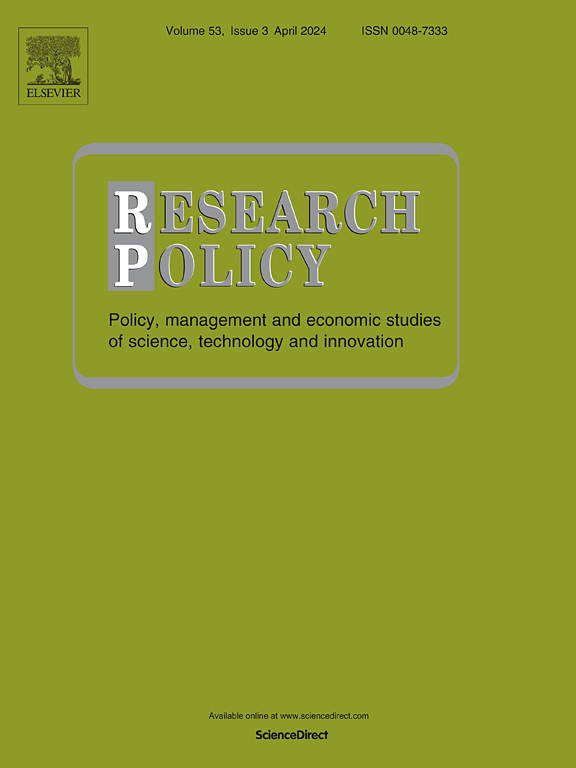Dominance of leading business schools in top journals: Insights for increasing institutional representation
IF 8
1区 管理学
Q1 MANAGEMENT
引用次数: 0
Abstract
The competitive push for business schools to publish in prestigious journals has resulted in a disproportionate number of papers in prestigious Management and Operations Research/Management Science (OR/MS) journals coming from a select group of institutions. Our analysis shows the Matthew effect of prestigious journals favors established schools with 51.2 % of papers in 18 Management ABS 4* journals and 61.3 % of papers in 3 OR/MS ABS 4* journals involving authors from the 100 top business schools identified by the University of Texas at Dallas (UTD). Citation patterns are similarly concentrated among papers authored by scholars from UTD-listed business schools, with nearly 80 % of citations from 4* Management journals directed to equally rated 4* Management journals (67.8 % for 4* OR/MS journals). An initial regression analysis suggested a positive correlation between the percentage of papers in a journal attributed to authors affiliated with those leading business schools and journal citation performance. However, further examination using multi-level regression adjusted for journal prestige, using the ABS and FT50 lists, showed a negative interaction effect on citation rates for papers from these schools in prestigious OR/MS journals. This insightful finding was confirmed by a post-hoc comparison revealing no significant citation advantage in prestigious journals for papers from leading business schools over those from a broader range of institutions. Thus, while leading business schools benefit from disproportionate space in prestigious journals, this does not translate to a citation advantage for the journals themselves, indicating no Matthew effect at the journal level driven by these schools. We argue that our findings show a unique opportunity for prestigious journals and business schools to expand collaborations with institutions in geographies historically underrepresented without a significant impact on the citation performance of those journals. This inclusion would only benefit research excellence, as our results demonstrate convergence in citation rates, citation patterns on external research areas, and topics across both subsets of papers—from leading institutions and those from a broader institutional spectrum—published in prestigious journals, indicating that diversifying contributions does not compromise the performance of these journals.

顶尖商学院在顶级期刊上的主导地位:增加机构代表性的见解
商学院竞相在知名期刊上发表论文,导致一些机构在知名的管理与运筹学/管理科学(OR/MS)期刊上发表的论文数量不成比例。我们的分析显示,知名期刊的马太效应有利于知名商学院,18种Management ABS 4*期刊中有51.2%的论文,3种OR/MS ABS 4*期刊中有61.3%的论文,作者来自德克萨斯大学达拉斯分校(UTD)确定的100所顶级商学院。引用模式同样集中在utd名单上的商学院的学者撰写的论文中,近80%的4*管理期刊引用指向同样评级的4*管理期刊(4* OR/MS期刊引用67.8%)。初步的回归分析表明,在期刊上发表的论文中,隶属于这些顶尖商学院的作者所占的比例与期刊引用绩效呈正相关。然而,利用ABS和FT50榜单对期刊声望进行调整后的多层次回归进一步研究显示,这些学校的论文在著名的OR/MS期刊上的被引率存在负交互作用。一项事后比较证实了这一富有洞察力的发现,该比较显示,在著名期刊上,来自领先商学院的论文与来自更广泛机构的论文相比,没有明显的引用优势。因此,虽然一流商学院受益于在知名期刊上不成比例的版面,但这并没有转化为期刊本身的引用优势,这表明这些商学院在期刊层面上没有马太效应。我们认为,我们的研究结果为知名期刊和商学院提供了一个独特的机会,可以扩大与历史上代表性不足的地区的机构的合作,而不会对这些期刊的引用表现产生重大影响。这种纳入只会有利于研究的卓越性,因为我们的结果表明,在引用率、外部研究领域的引用模式和主题上,来自领先机构和来自更广泛机构的论文子集在著名期刊上发表,表明多样化的贡献不会影响这些期刊的表现。
本文章由计算机程序翻译,如有差异,请以英文原文为准。
求助全文
约1分钟内获得全文
求助全文
来源期刊

Research Policy
MANAGEMENT-
CiteScore
12.80
自引率
6.90%
发文量
182
期刊介绍:
Research Policy (RP) articles explore the interaction between innovation, technology, or research, and economic, social, political, and organizational processes, both empirically and theoretically. All RP papers are expected to provide insights with implications for policy or management.
Research Policy (RP) is a multidisciplinary journal focused on analyzing, understanding, and effectively addressing the challenges posed by innovation, technology, R&D, and science. This includes activities related to knowledge creation, diffusion, acquisition, and exploitation in the form of new or improved products, processes, or services, across economic, policy, management, organizational, and environmental dimensions.
 求助内容:
求助内容: 应助结果提醒方式:
应助结果提醒方式:


